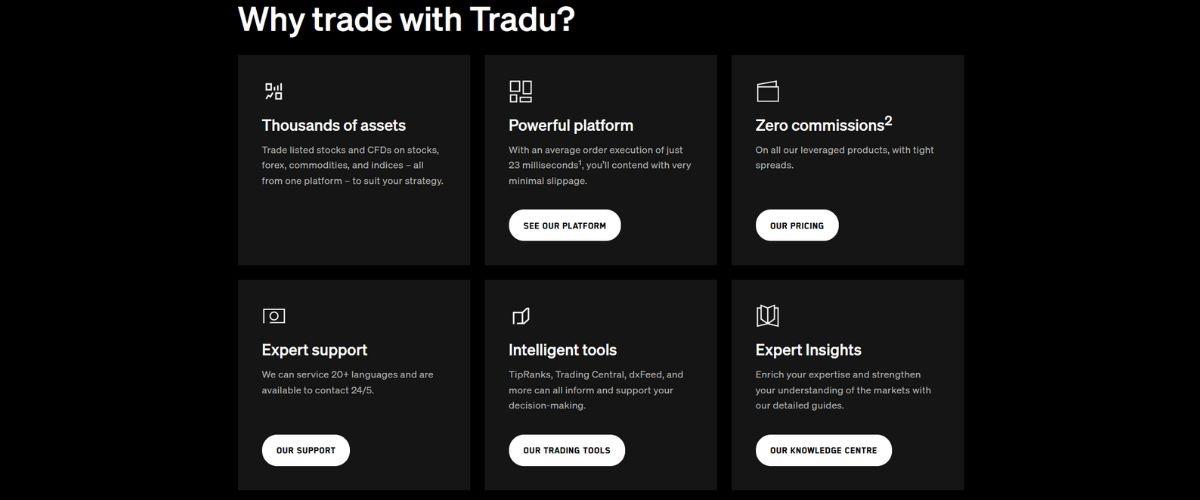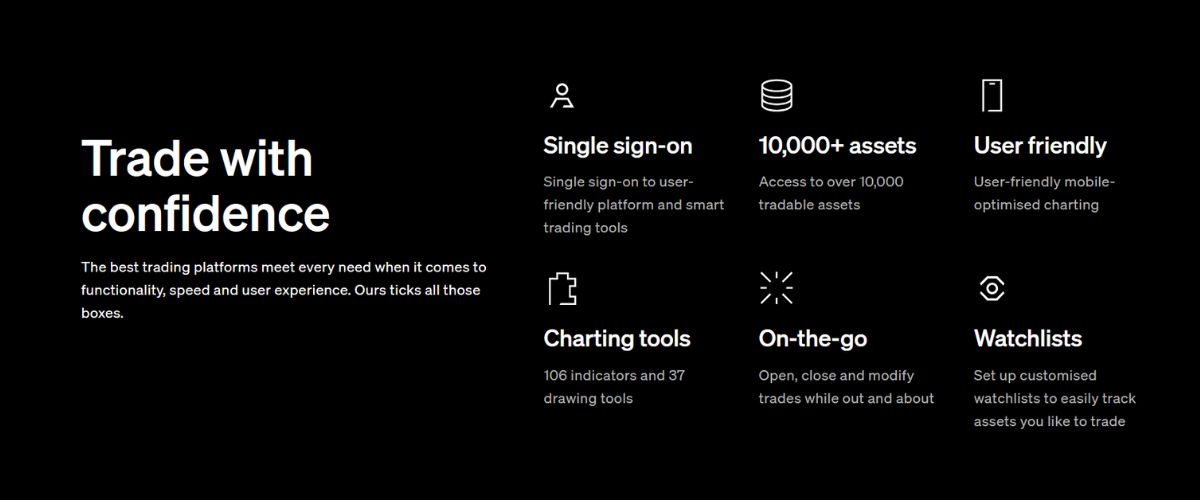Tradu entered the trading scene with big claims and clean design, backed by the weight of Jefferies Financial Group, a name that gives it instant credibility. On paper, it sounds like a retail trader’s dream: thousands of instruments, low-cost trading, sleek proprietary platform, and regulated under the FCA and CySEC. It’s clear they’re aiming to be the modern, all-in-one solution that blends long-term investing with short-term CFD trading.
But beyond the branding and high-gloss interface, the picture isn’t without flaws. There’s only one account type, no demo access, and a few glaring gaps in what UK-based traders might expect, like proper FSCS protection once funds are moved into a trading account. Add to that the lack of advanced platform options, and it starts to feel like a platform built more for casual traders than serious, high-volume users.
So, is Tradu a sleek solution or simply style over substance? Let’s unpack what they offer and what they don’t.
Only Trade with Regulated and Reputable Brokers
| List of Forex Brokers | List of CFD Brokers |
What Tradu Has to Offer

Why choose Tradu – broker features
Regulation and Safety
Tradu operates under multiple regulatory bodies:
- Financial Conduct Authority (FCA) – UK: Authorized via Stratos Markets Limited.
- Cyprus Securities and Exchange Commission (CySEC) – EU: Regulated through Stratos Europe Ltd.
- Financial Sector Conduct Authority (FSCA) – South Africa: Registered under Stratos South Africa (Pty) Ltd.
- Financial Services Authority (FSA) – Seychelles: Offshore license held by Stratos Systems Ltd.
While the FCA and CySEC licenses provide a degree of credibility, it’s essential to note that Financial Services Compensation Scheme (FSCS) protection applies only to uninvested client funds. Once funds are moved into trading accounts, this protection does not extend, which may concern traders seeking comprehensive fund security.
Trading Platform
Tradu runs on its own proprietary platform, built from the ground up. It’s a clean, modern interface — clearly designed with mobile-first functionality in mind, but the desktop/web experience holds up well too. You won’t find third-party platforms like MetaTrader here, which could be a let-down for those who rely on automated trading tools or custom indicators.
That said, the in-house platform covers a lot of ground:
- Real-time charts with basic technical indicators
- Integrated news feeds and analyst commentary
- Customisable watchlists, alerts, and trade tickets
- A clear portfolio overview that breaks down asset exposure

Tradu trading platform features
Execution is quick, navigation is smooth, and the layout is intuitive, but it’s definitely geared more toward casual traders than those who need deep functionality or algorithmic flexibility. A decent experience overall, just not one designed for power users.
Account Types
This is where Tradu really keeps things minimal: there’s only one standard account. No tiered structure, no ISAs or SIPPs, and, surprisingly, no demo account either. For new traders who want to test the waters without risk, that’s a major miss.
You get access to all available markets through a General Investment Account (GIA). There’s no minimum deposit, which is good news, but no ability to create different profiles or risk levels. This keeps things simple — but it also feels a bit one-size-fits-all in a space that usually values flexibility.
Markets and Instruments
One area where Tradu genuinely shines is its breadth of assets:
Tradu doesn’t support crypto or ETF trading, which might be a sticking point for traders looking for broader exposure, but for equity-focused users, the core offering is solid and streamlined.
Spreads and Fees
Tradu keeps its pricing structure relatively transparent, and to its credit, there are no surprise charges hiding in the small print:
The overall cost structure won’t scare anyone off, but it’s definitely worth checking how it stacks up against brokers with more aggressive spreads or commission-free models.
Trading Tools and Features
This is one of the platform’s stronger areas. While the platform doesn’t offer deep customisation or automation, it provides several tools to make decision-making more informed:
It’s a well-rounded toolkit for most everyday traders, though again, not designed with the institutional crowd in mind.
Deposit and Withdrawal Methods
Tradu supports most of the essential funding channels, and the good news is there are no deposit or withdrawal fees: bank transfers, credit/debit cards, e-wallets.
There’s also no minimum deposit, which makes onboarding extremely simple. However, the lack of local funding methods for certain regions might be an obstacle depending on where you’re trading from.
Tradu Pros and Cons
Pros
Cons
Tradu’s Reviews from the Web
Tradu currently holds a strong Trustpilot rating, based on a small but growing number of reviews. Most users highlight the platform’s ease of use, clean interface, and smooth onboarding process. The user experience, particularly on mobile, is frequently praised — with traders noting that the layout is intuitive and fast to navigate. A number of reviewers also mention responsive customer support, describing it as helpful and quick to resolve basic account or platform issues.
That said, the feedback isn’t entirely glowing. A few users point out the lack of certain features, like demo accounts or more advanced charting tools, and mention that the $50 inactivity fee can feel excessive for more passive investors. Educational resources are also seen as fairly limited. While the current reviews are overwhelmingly positive, it’s worth noting that Tradu is still relatively new to the market, so broader feedback will offer a clearer picture over time.
Tradu Verdict: Built for Convenience, Not Depth
Tradu ticks the right boxes on the surface: sleek design, multi-asset access, FCA regulation, and backing from a major financial group. It’s the kind of platform that looks and feels modern, especially if you’re a casual trader or just starting to dip into markets. Add in the low trading costs and clean interface, and it’s easy to see why it’s turning heads.
But beneath that polish, it’s missing key features that more experienced traders would expect. No demo account, no account flexibility, no advanced platform support, and a few regulatory blind spots make it harder to fully endorse. And with a £50 inactivity fee on top of that, it’s not exactly “set and forget” friendly either.
In short: Tradu works best for hands-on, self-directed traders who want a mobile-first experience and a simple cost structure. But if you’re after long-term portfolio building, advanced tools, or deeper protection, it’s probably not the one.



